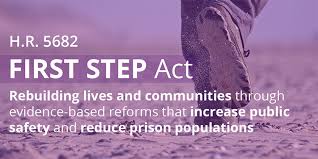In December 2018, President Donald Trump signed into law the First Step Act (FSA), also known as the Formerly Incarcerated Reenter Society Transformed Safely Transitioning Every Person Act. This is a bipartisan criminal justice bill that was passed by the 115th Congress and aims to reform federal prisons and sentencing laws. The hope is that this pilot program will lead the way for other recidivism reduction programming and decrease the federal prison population while maintaining overall public safety.
There are many parts of the FSA, and many sections can benefit federal inmates who have been admitted into the criminal justice system. We’ll take a look at some of these benefits below.
#1. Risk and Needs Assessment Systems
A huge part of the FSA focuses on developing a Risk and Needs Assessment System. All federal inmates are to be assessed within 180 days of entering the system and classified as having either a minimum, low, medium or high risk. Based on these risk levels, federal inmates will then have access to different programs and systems that will help reduce recidivism.
Thanks to the FSA, the Bureau of Prisons (BOP) is required to provide all prisoners with an opportunity to participate in recidivism reduction programs, with priority given to high- and medium-risk inmates. Those who successfully participate in these programs are to be given rewards and incentives like:
- Additional phone and video conferencing privileges of up to 30 minutes a day and up to 510 minutes a month
- Additional visitation times, as determined by the warden
- Transfer to a facility that’s closer to the inmate’s release residence
- Increased commissary spending limits and product offerings
- Greater email access
- Early release through good time credit
The details of participation will vary in each of the facilities, and eligibility will be based on assessment tools that may also vary. Understanding the details of each prison is key to understanding how to take advantage of the FSA.
#2. Sentencing Reforms
A section of the First Step Act has made significant sentencing reforms that could have a huge effect on federal inmates. Most of these reforms benefit inmates and include:
- Reducing mandatory minimum sentences. The First Step Act has reduced the mandatory minimum sentences for drug traffickers with prior drug convictions from 20 years to 15 years. The life sentence mandatory minimum has also been reduced to a 25-year mandatory minimum.
- Expanding the safety valve. Federal inmates with minor criminal records are not eligible for the safety valve provision, which essentially allows judges to sentence nonviolent, low-level offenders to term imprisonment that is less than the mandatory minimum.
- Getting rid of the stacking provision. Sentences are less likely to be stacked together.
There are many other ways that the sentence reforms can benefit federal inmates, especially those with drug offenses. In fact, this section of the act has a huge effect on a large majority of the federal prison population due to the fact that many inmates have some type of drug charge or struggle with a substance abuse disorder.
#3. Lax Eligibility for Compassionate Release
Previously, all federal prisons and penitentiaries offered compassionate release, as long as the inmates were able to demonstrate an “extraordinary and compelling reason” for a reduction in sentence. This usually happens when an inmate is deathly sick and would fare better in home confinement.
Despite the widespread eligibility of this, those who seek compassionate release are often unable to due to the cumbersome administrative processes that are involved. Those who wished to receive compassionate release would need to petition the BOP and participate in their administrative process. This process was not only time-consuming but also difficult, as the decision was left to the BOP rather than the sentencing court.
The FSA has changed this completely to allow sentencing judges to consider defense motions directly in various situations, like if the BOP has failed to act on a request within 30 days of receipt. This section of the act will effectively prevent BOP from being a gatekeeper of compassionate release processes and will give the discretionary power back to the courts
#4. Reauthorization for Grants and Funding for Numerous Programs
Last but not least, one of the main things that the FSA did was reauthorize grants and funding for numerous programs, like substance abuse treatment programs, careers training demonstration programs, and more. Some of the grants are also being used to evaluate and improve the educational methods that are available at these facilities, so inmates can enjoy better academic and vocational education methods.
This increase in funding can be beneficial for many federal inmates. Those who struggled with a substance use disorder may qualify for the Residential Drug Abuse Program (RDAP), which could help them kick their addiction and learn how to better handle their cravings. Those who successfully complete one of these programs may also be eligible for sentence reductions. With RDAP, those who successfully completed the program may be eligible for a sentence reduction of up to one year! C
Contact Us for More Information
The FSA is fairly complicated. There are many different clauses and sections that can affect each inmate’s situation . For example, the Second Chance Reauthorization Act of the FSA also has a BOP early release pilot program that allows the BOP to place elderly, nonviolent offenders who are above the age of 60 on home confinement instead. This will allow them to be a lot more comfortable while serving out their time. It’ll also allow them to be close to loved ones.
. For example, the Second Chance Reauthorization Act of the FSA also has a BOP early release pilot program that allows the BOP to place elderly, nonviolent offenders who are above the age of 60 on home confinement instead. This will allow them to be a lot more comfortable while serving out their time. It’ll also allow them to be close to loved ones.
Those who have been convicted of a federal crime and would like to learn more about how the FSA may benefit them should contact us immediately. We can look at the criminal histories of each individual, as well as their area, to provide more detailed information on how the FSA may affect them.


